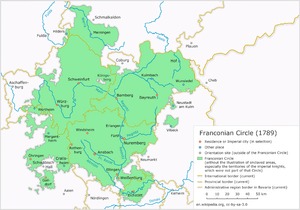Franconian Circle

The Franconian Circle as at the beginning of the 16th century

The Franconian Circle as at 1789, before the French Revolutionary Wars and the dissolution of the Holy Roman Empire.

The flag of Franconia as used by troops of the Franconian Circle when fighting with the Imperial Army.
The Franconian Circle (German: Fränkischer Reichskreis) was an Imperial Circle established in 1500 in the centre of the Holy Roman Empire. It comprised the eastern part of the former Franconian stem duchy — roughly corresponding with the present-day Bavarian Regierungsbezirke of Upper, Middle and Lower Franconia — while western Rhenish Franconia belonged to the Upper Rhenish Circle. The title of a "Duke of Franconia" was claimed by the Würzburg bishops.
Composition
The circle was made up of the following states:
| Name | Type of entity | Comments |
|---|---|---|
| |
Margraviate | Established in 1398, held by the House of Hohenzollern, acquired by Prussia in 1791 |
| |
Prince-Bishopric | Diocese established in 1007 by King Henry II, Prince-Bishopric since about 1245 |
| |
Margraviate | Established in 1398 at Kulmbach, held by the House of Hohenzollern, personal union with Ansbach from 1769, acquired by Prussia in 1791 |
| |
County | Imperial counts since 1202 |
| |
Prince-Bishopric | Established in 741 by Saint Boniface |
| |
County | Imperial counts from 1532 |
| |
Teutonic bailiwick | Seated in Bad Mergentheim |
| |
Lordship | Held by Bamberg since 1007, condominium with Bayreuth and Nuremberg from 1538 |
| |
Princely County | Principality since 1310, line extinct in 1583, acquired by Saxe-Weimar and Saxe-Gotha in 1660 |
| |
County | Immediate counts since 1450, raised to principality in 1744 |
| |
Lordship | Territory around Limpurg Castle near Schwäbisch Hall, held by the Schenken von Limpurg, hereditary cup-bearers of the Empire for the Bohemian kings |
| |
County | Imperial immediacy since 1494, Löwenstein-Wertheim from 1574, raised to principality in 1711 |
| |
Imperial City | Reichsfreiheit granted by Frederick II of Hohenstaufen in 1219 |
| |
Lordship | Territory around Reichelsberg Castle near Aub, originally a fiefdom granted by Bamberg to Hohenlohe, since 1401 a fief of Würzburg |
| |
County | Territory around Rieneck Castle, established in 1168, claimed as a fief by Mainz from 1366, line extinct in 1559, acquired by the Imperial counts of Nostitz in 1673 |
| |
Imperial City | Reichsfreiheit granted by Rudolph of Habsburg 1274 |
| |
Lordship | Established in 1429 by the Lords of Seinsheim, territory around Schwarzenberg Castle near Scheinfeld, Imperial county from 1599, principality from 1670 |
| |
Imperial City | Since 1254 |
| |
Lordship | Held by the Counts of Schwarzenberg from 1655 |
| |
Imperial City | Since 1296 |
| |
Lordship | Fiefdom of Württemberg, from 1379 to 1713 in possession of the Schenken von Limburg |
| |
County | Established in 1132, acquired by Löwenstein in 1574 |
| |
Lordship | Imperial county from 1678, acquired by the Counts of Schönborn in 1701 |
| |
Imperial City | Since 1248 |
| |
Prince-Bishopric | Established in 741 by Saint Boniface, prince-bishopric since 1168, titular "Duke in Franconia" |
See also
Sources
- The list of states making up the Franconian Circle is based on that in the German Wikipedia article Fränkischer Reichskreis.
External links
- Imperial Circles in the 16th Century – Historical Maps of Germany
This article is issued from Wikipedia - version of the 9/1/2016. The text is available under the Creative Commons Attribution/Share Alike but additional terms may apply for the media files.
-en.png)